By: debbie lynn elias
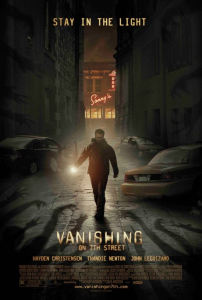
Director Brad Anderson has long been a force to be reckoned with when it comes to horror and suspenseful psychological thrillers. Harkening back to days gone by when terror was created by suspense and the fear of the unseen and unknown as opposed to slash and hash, Anderson has always been one to masterfully enthrall us with mood and story created through intelligence and capitalizing on innate fear of the unseen and unknown. People fear what the darkness hides. But what exactly is the darkness hiding? With VANISHING ON 7TH STREET, Anderson poses that very question and has you jumping out of your skin while pondering it. A fascinating post-apocalyptic premise that’s even more fascinating to watch unfold, characters draw you ever deeper, probing, ever probing. Light and shadows terrorize your soul as the intrigue builds and your own soul searching grows. You can’t look away. You can’t move. Your mind reels looking for answers and clues. You are mesmerized by the darkness…and the light. This is the stuff that true horror and suspense are made of. And it’s all here in one exciting package called VANISHING ON 7th STREET.
Detroit is blanketed in darkness. A mass power outage has shuttered the city. Who knows if it extends beyond the City as there is not even any form of satellite communication. It’s as if Detroit is cut off from the rest of the world. But this feels like more than just darkness, especially to Luke, an investigative news reporter, and Paul, a projectionist for the local AMC movie theater. Although a reporter, Luke is more of a “happy talk” pretty camera face than hard hitting journalist, but there’s something in him that yearns to be more. Paul, on the other hand, is fueled by the magic of the movies and is essentially a student of history, taking very notable interest in unexplained phenomena and events. He probes and asks the questions one would expect a journalist to do.

During a late night showing at the theater, power goes out. Paul, immersed in one of his books, is caught off guard but unphased. Wearing his ever present head lamp (gotta have some sort of light to read during the movie), he ventures into the theatre only to find it completely empty with nothing more than clothing in each of the seats. Where are the people? Going out into the mall, there is silence. No people, no panic, no nothing…but for piles of clothing throughout the mall corridors. He sees a security guard. But when the guard’s flashlight goes out, the guard disappears.
At a local hospital, darkness also strikes and even the emergency lighting fails, leaving a frightened young physical therapist named Rosemary panicked and afraid, especially when her baby who was in the nursery goes missing with the darkness.
As morning breaks, we find Luke awakening to an empty apartment. Candles that had been burning by his bedside are now extinguished. Finding that he has no electricity, Luke is oblivious to anything out of the ordinary. It’s daylight, he can find his way around just fine. Heading out to the tv studio, Luke enters the sunshine, but something is amiss. Cars are abandoned in haphazard fashion. Piles of clothes are on the street. People are scarce. Arriving at work, although monitors are running feeds from around the country, there is no one there. But then the monitors go dark. The tv station is plunged into darkness and shadows fill the halls where there was once light. For Luke, it’s as if the shadows are coming after him.
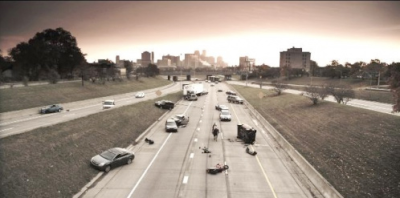
By nightfall, the situation has gone from bad to worse as darkness creeps across the city, swallowing every person in its path. Using flashlights, glow sticks, whatever they can find, slowly Luke, Paul and Rosemary all make their way to a rundown local bar, Sonny’s, a place bathed in light and music with only a little boy named James on the premises. Patiently waiting for his mother to return, James follows her instructions to keep the generator running and the lights on. Whatever he does, James cannot let the place go dark. He must keep the generator running. But what happens when the gas runs out and the generator goes quiet? And why are these four still alive? What has brought each of them here?
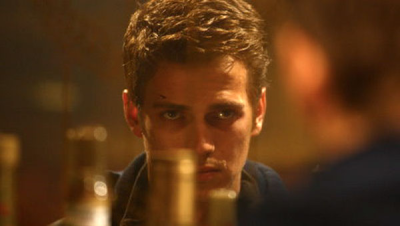
Hayden Christensen easily fills the shoes of Luke. Best known as Anakin Skywalker in the “Star Wars’ prequels, Christensen has a commanding on screen presence that easily conveys attitude and arrogance, traits that bode well for Luke. For much of the film, Luke is, to put it bluntly, a jackass. He has no regard for anyone but himself. He is not likeable. I found myself wanting the dark to take him away. But then there is a shift, some redemption, which creates an interesting scenario for the film’s finale. Will Luke go “the dark side” or will he stay in the light. Christensen is at his most compelling in the third act.
I normally love Thandie Newton, but here as Rosemary, her performance is a bit uneven. She vacillates between intelligence and random hysteria which is too over-the-top and like Christensen, pushes one to the point of hoping darkness will consume her.
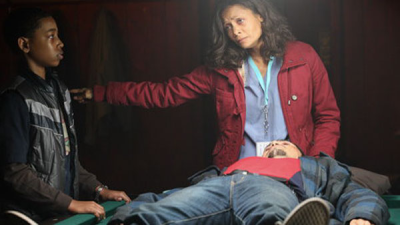
John Leguizamo and Jacob Lattimore are standouts. As Paul and James, these two are the connective tissue of the story. Leguizamo’s Paul establishes the premise of unexplained scientific phenomena and fuels the energy of the film. Lattimore, together with another little child gem, Briana Groothuis, bring the story full circle giving us much existential food for thought. Only 12, Lattimore has the nuance and skill of a seasoned professional. His range of emotion is believable and solid while bringing a great innocence to the story.
Written by Anthony Jaswinski, VANISHING ON 7TH STREET permeates sinister intrigue laced with hopeful, and questioning, innocence. Relying on enigmatic conjecture created early on through the character of Paul, Jaswinski transports us into places, our minds don’t dare go…the whys of the universe, life, death, immortality…all of which is never discussed or answered, but merely posited for the audience. The story is so well told and thanks to Brad Anderson’s keen eye, so well visualized, that all we need is a sliver of information to set the mind reeling. The fact that we are never told the, who, what, where, why just adds to the intrigue and suspense as you find yourself subconsciously searching for answers which gasping in terror as the film progresses. Each main character is individually established with just enough story that we get a sense of who they are, allowing the true terror to remain unfettered.
Without revealing the ending, I will only say that it is brilliant with a very Biblical sensibility to it.
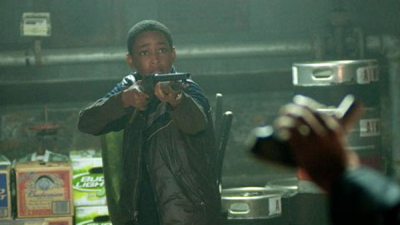
Key to VANISHING ON 7TH STREET is the use of light and dark as characters. Cinematography is impeccable using a texturization of blacks, greys, muted ambers and umber tones with the brilliance of halogen lights popping up now and again as well as candles, dim neon reflections of crack lights and light-up sneakers. Two red flares also pop up; nice symbolism for an emergency …or hell. Interestingly, to create the effect we see on screen, Anderson and cinematographer Uta Briesewitz, actually flooded the sets with light and then removed the light in post-production. This technique allowed them to control the darkness and the limited punctuated use of light, creating a disquieting eeriness and paranoia that just intensifies over the course of the film. Thanks to minimal but effective use of CGI, the inky blackness that creeps over the city looks reminiscent of the effect we saw in “Ghost” when “bad people” were taken away …which also had me thinking throughout VANISHING ON 7TH STREET, all these people are bad and don’t deserve to “go into the light.” Interesting hypothesis.
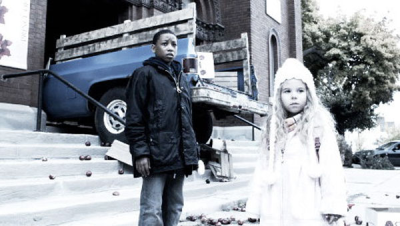
Sound is also a significant factor in VANISHING ON 7TH STREET and is so fine tuned so as to allow the whisper of a baby’s cry, clip clop of a horse’s hoof, the barking of a dog in the distance, create nuanced subtext that fuels the existentialism of the story. Likewise, Lucas Vidal’s music compliments the film’s tone every step of the way.
Do you fear the unknown? Do you fear what the darkness hides? Then you need to know what’s VANISHING ON 7TH STREET.
Luke – Hayden Christensen
Paul – John Leguizamo
Rosemary – Thandie Newton
James – Jacob Lattimore
Directed by Brad Anderson. Written by Anthony Jaswinski.












